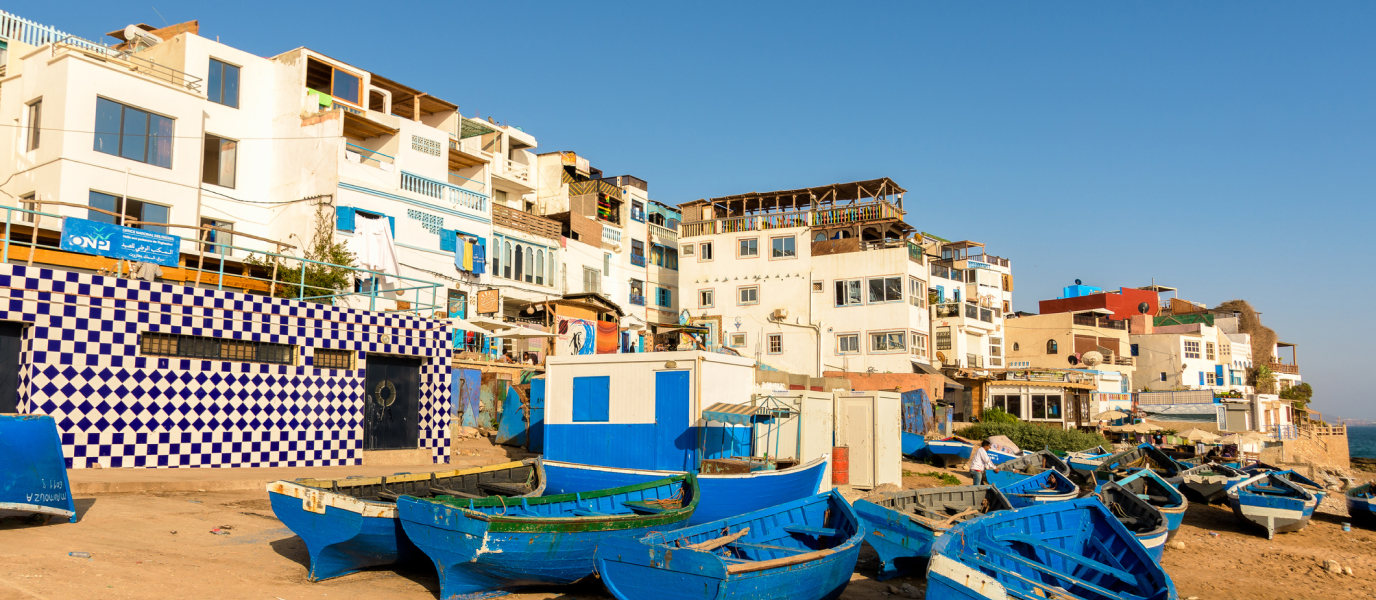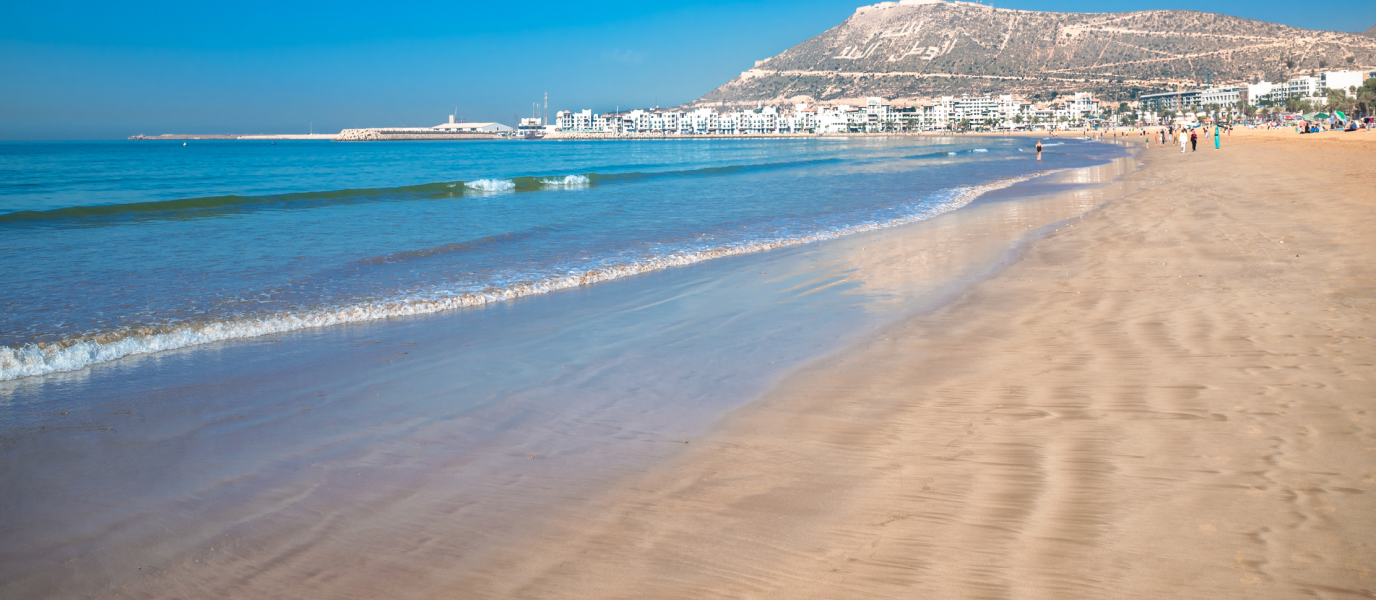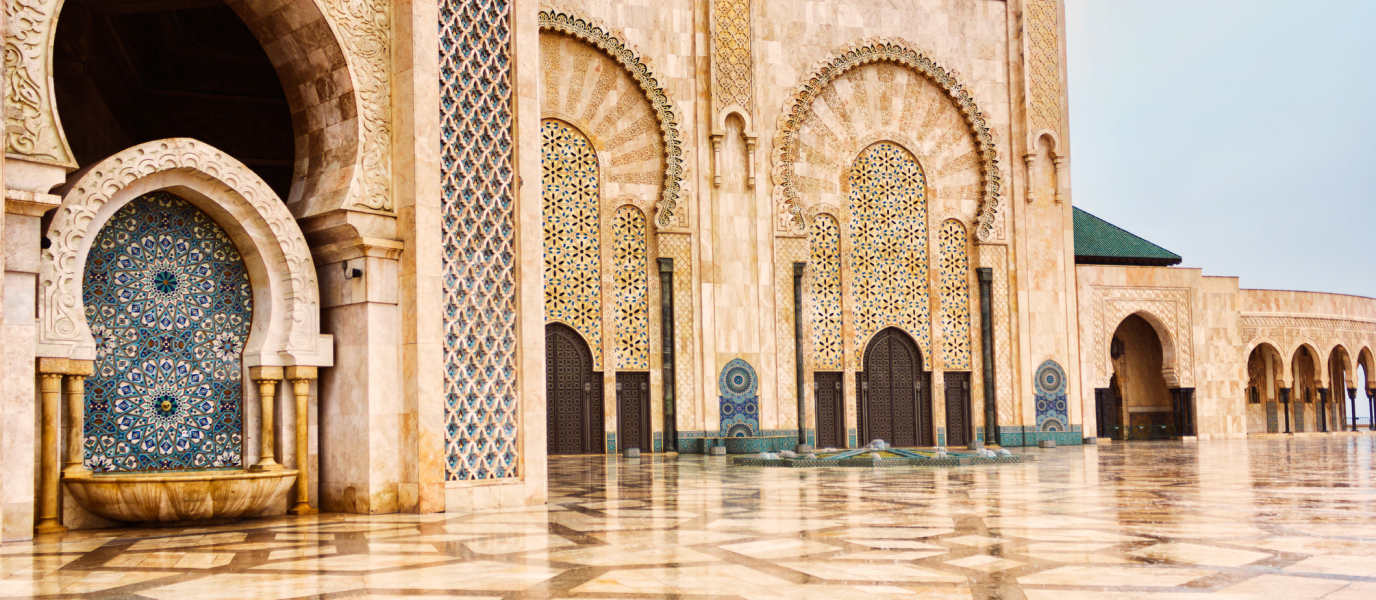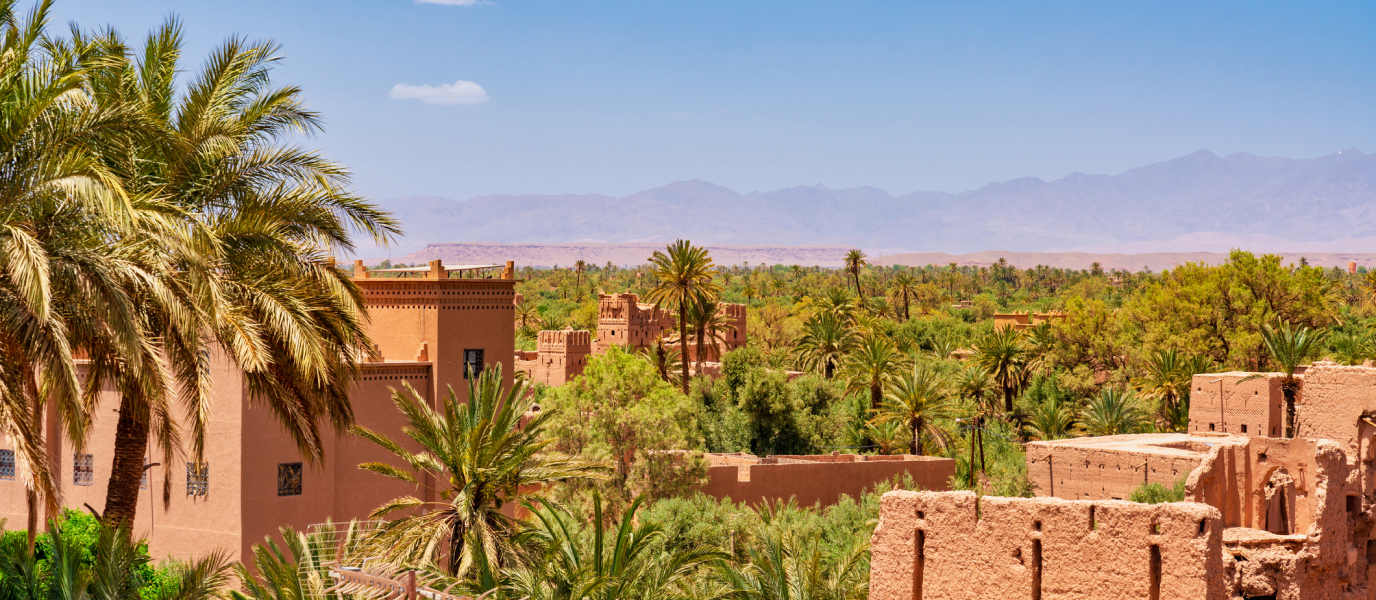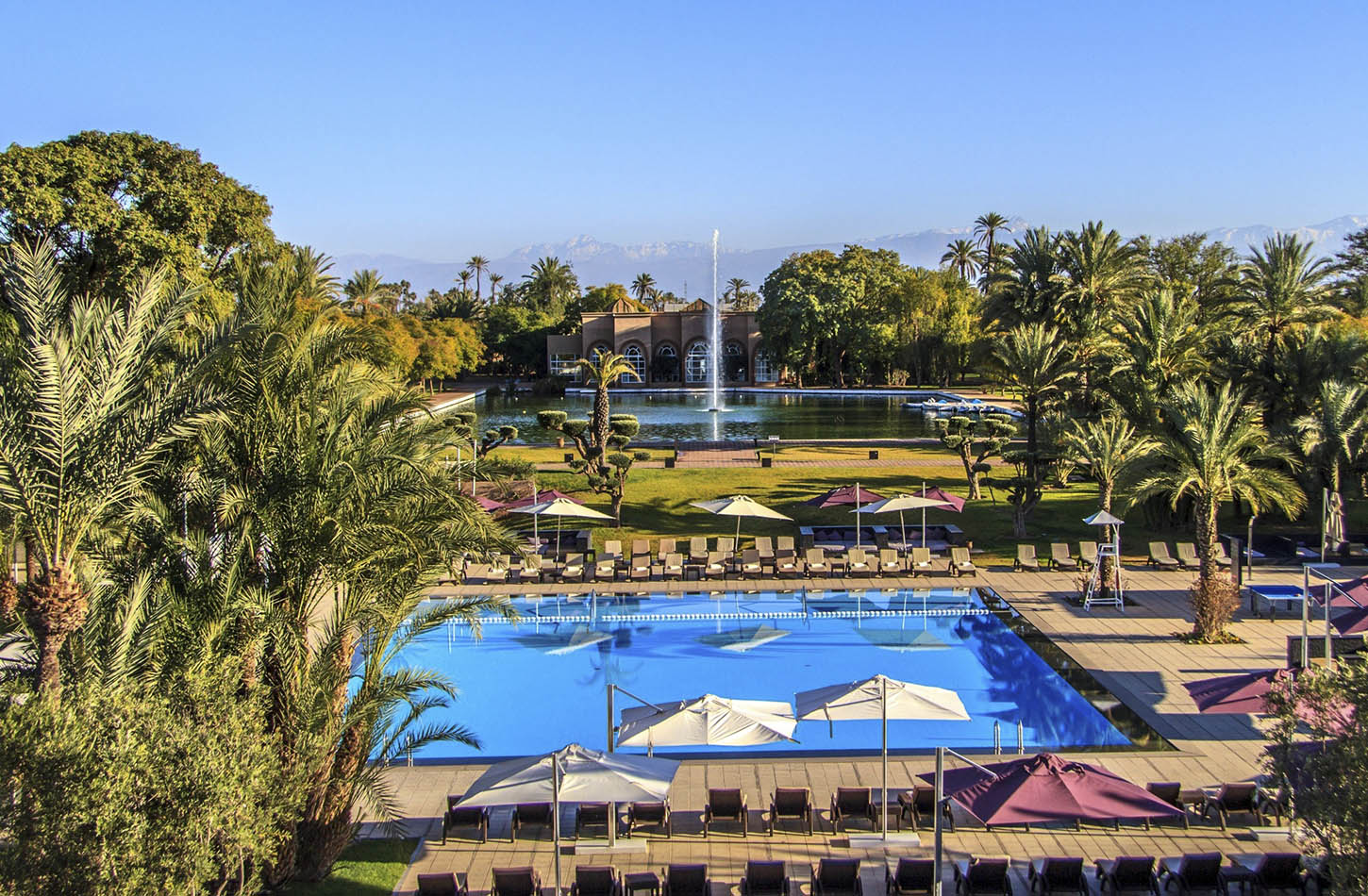Located on the gulf of the same name, and bathed by the Atlantic, Agadir is the perfect choice for those looking to enjoy a beautiful beach setting in Morocco. Protected from the winds and dryness of the desert by the Anti-Atlas mountain range, Agadir’s beach is close to the city centre. The beach is also called Agadir, and is one of the city’s main attractions.
Founded by the Portuguese during the sixteenth century, the entire city was destroyed by an earthquake in 1960. It had to be rebuilt from nothing, and many of its main buildings are sited close to the seafront. On top of the hill on which the Kasbah stands, a few vestiges of the old walled city can still be seen. Nowadays, the urban landscape is modern and vibrant, but retains the characteristic features of a Muslim country, with its souks and mosques.
Agadir beach is in the heart of the city
Visitors are entranced by this vast beach of smooth, golden sand, with its calm waters. It is nine kilometres long, and lies at the very heart of the city. Local and foreign tourists mix in this setting, which enjoys good weather almost the whole year round. The beach offers every possible facility required to enjoy relaxing and bathing: sunshades, loungers, and a good choice of cafés and restaurants on the nearby seafront promenade.
The beach is well known for its water sports, including water skiing, parascending, sailing, kitesurfing, and windsurfing. As the beach is so large, football matches are played on certain parts of it, and activities such as quad biking, dune buggy driving, horse riding, and camel rides are undertaken — all without the slightest disturbance to those who just want to soak up the sun.
Although it is sheltered from the winds, Agadir is known for its rip currents, so caution is advised when swimming in its clear Atlantic waters. Every evening, the sunset attracts a great many spectators who gather on the beach or stroll along the seafront promenade. The beach stretches from the marina in a southerly direction towards the more modern tourist area. Very close to Agadir beach are the beaches of Tamraght and Taghazout, very well known to surfers.
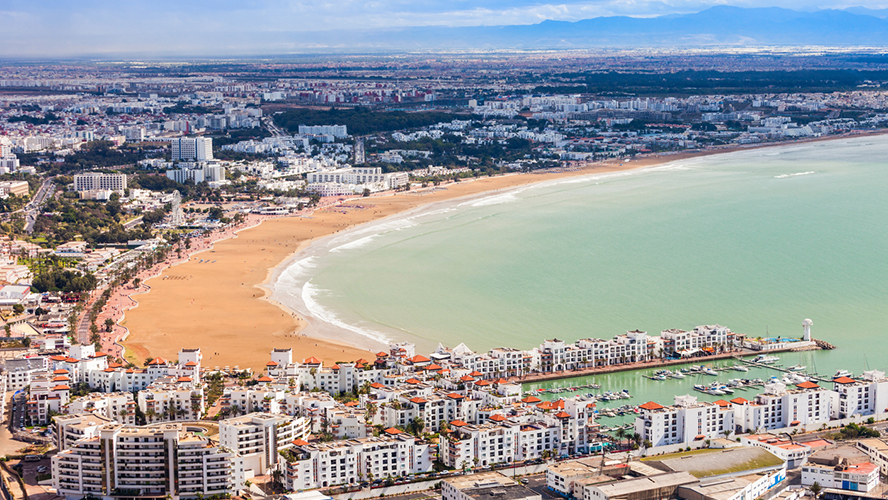
Agadir’s marina, glamour in a fishing area
Agadir Marina, at the far northern end of the bay, is an extremely popular social hub in the city. This is a glamorous spot, with luxury boats and yachts. But there are also lots of shops, restaurants and snack bars. The marina, busy throughout the year thanks to its excellent location and climate, offers mooring places for 300 vessels up to 30 metres in length. But that greatest attraction for travellers is the famous traditional fishing port, which lies very close by.
There are regular morning fish markets. It is worth coming here to absorb the atmosphere, see the market, and enjoy the setting and the sight of the boats returning once their work is done. There is an area of eateries where you can enjoy fresh fish and good quality seafood.
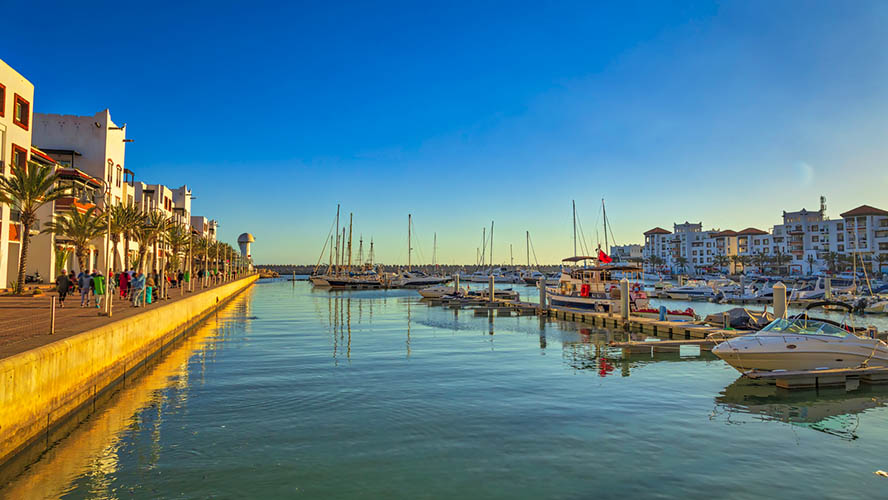
The Mohamed V Mosque and the Loubnan Mosque
Mosques are a very important element of Morocco’s urban landscape. There are an enormous number of mosques, and their silhouettes feature prominently in every city. It is calculated that there are over 50,000 across the country, with new ones are being built all the time.
The most important mosques in Agadir are the Mohamed V Mosque and the Loubnan Mosque. The Mohamed V Mosque is the city’s largest, and is located in the bustling neighbourhood of Nouveau Talborjt, on Avenue Président Kennedy. It is set in a large square next to a peaceful garden. It was built in 1960, as the original mosque was destroyed by the earthquake that devastated the city.
Its exterior is remarkable, with decorative details in wood against its white façade. The mosque’s tall minaret can be seen from a great distance, and is a reliable point of reference for anyone visiting the city. Exquisite mosaics decorate the interior but, as is the case with almost all Morocco’s mosques, only those who practise the Muslim religion are allowed inside to see them.
The Loubnan Mosque stands in the heart of Agadir, very close to the beach, between Avenue des Far and Avenue du Prince Moulay Abdallah. It is somewhat surprising to find a large mosque in the midst of a tourist resort. It was opened in September 1969 by King Hassan II. Both places are very busy during the daytime, as the most devout men come to pray up to five times a day. The largest crowds converge on the mosques on Fridays at midday.
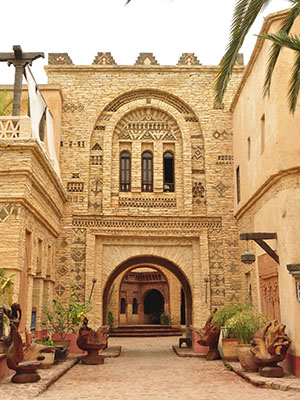
The Medina, an area of new building
Agadir’s New Medina in the southern half of the city is a great attraction. In contrast to the attachment to the past displayed by other places, here everything is modern. The old neighbourhood was destroyed by the 1960 earthquake. Towards the end of the twentieth century, it was decided to commemorate the neighbourhood that had once stood here with a new development covering 12,000 m2.
The New Medina, designed by the architect Coco Polizzi, is also known as the Polizzi Medina, and always astonishes visitors with its unique, monumental appearance and its beauty. It has the appearance of a medieval town, something unique in the local area. The complex’s design respects the most significant traditional elements of the original Medina. Although there is a charge for admission, this is an ideal place to appreciate the area’s traditional crafts and cuisine. As with almost all such attractions in Morocco, it is open to visitors all day from early morning until mid-evening.
The old Kasbah — a glance back to the past
Half an hour’s walk from Agadir’s Marina, you will find the old Kasbah, one of the very few places not completely erased by the horrific earthquake. The only parts left standing were sections of the walls and the entrance gateway. At the entrance, you can read an inscription in Dutch, dated 1746, which reads: “Fear God, and respect the King”. At the time, the Dutch had a factory in the city, and the vestiges they left are part of what little survives of Agadir’s past — before it became the tourist hub that it is today.
Perched on a hilltop, it is one of the city’s loveliest spots. From a height of 236 metres, it dominates the port, and commands impressive views of the ocean and of the entire area. It is undoubtedly the perfect spot from which to watch the sun set over the bay.
The fortress was built in 1540 by Mohamed Ech-Cheikh (the founder of the Saadi dynasty), as a base for his besieging army, and it served later on to protect the city against attacks by the Portuguese. Two centuries later, in 1752, the fortress was strengthened by Moulay Abdallah.
Agadir’s Souk — traditional ambience
If you would like to enjoy a traditional shopping experience and to watch the flow of daily life in Agadir, you need to head for the El Had Souk. It is the best place to observe the hustle and bustle of the place and its customs. The Souk is a 45-minute walk from the beach, and is next to a mosque in Rue 2 Mars.
The souk has 13 entrances, and is made up of hundreds of little shops. It is the best place in the city to learn about the typical products of the area. As is usual in such places, one of the star attractions is the variety of aromatic spices in their fascinating colours. Another highlight is the craft items, the traditional clothing, and pieces of leatherwork. Not forgetting Morocco’s typical tea and Argan oil. There is also a section selling fresh meats (many of the animals are still alive until they are purchased), vegetables, fruits and pickles.
As in all souks, haggling is obligatory in order to obtain goods for the best possible price. The Souk is open from Tuesday – Sunday, from 9.00 a.m. until 6.00 p.m., although opening times for individual stalls may vary.
Crocodile Park and Birds Valley — places for families to visit
Time for relaxation and family fun is guaranteed in Agadir. The city has two attractions that combine the enjoyment of nature with leisure and education: Crocodile Park and Birds Valley. Crocodile Park is located in Drarga, a rural community 835 kilometres from the city — in an area planted with argan trees, and with the peaks of the Anti-Atlas mountains in the background.
This is a fantastic botanical garden, where visitors can see different types of plants, and where reptiles are the true stars of the show. This stunning setting, covering around four hectares, is home to almost 300 crocodiles, some of which come from the Nile and weight between 80 and 150 kilos.
Crocodile Valley’s recreations of tropical and aquatic habitats, and its little waterfalls, along with songbirds, are a source of delight to visitors. For children, there are places to rest and activities to help them learn about crocodiles, as well as a treasure cave.
From crocodiles, we move on to birds at Birds Valley, a favourite place for those who love birds and animals, as this attraction is also a zoo. Birds Valley is very close to the city’s seafront promenade on Boulevard du 20 Aout, 5 minutes from Jardin d’Olhao. Here, the whole family will be entranced by the lovebirds, parrots, macaws, and flamingoes. And in another section, you can see deer, gazelles, sheep, and other species of mammals.
Where to eat in Agadir: the best of Moroccan cuisine
Moroccan cuisine features subtle and varying flavours. The most typical dish is cous cous, but you can also enjoy beef, chicken or lamb tagines. And it’s almost obligatory to have brick or chorba. And to finish, traditional little cakes, not forgetting a mint tea.
In Agadir, there are three areas where you are guaranteed to find good food. In the bustling neighbourhood of New Talborjt, you will find Agadir’s cheapest restaurants. Secondly, the area around the beach is the most expensive and tourist-orientated. Here there are some excellent fish restaurants, but there are also establishments serving international and fast food. Thirdly, there is the mid-priced Uniprix area, with its mix of those restaurants catering for tourists and those more popular with local people.
If you’d like to try the very finest Moroccan cuisine, a good choice is the Bab Agadir Restaurant, in Avenue Hassan II. It is small, charming and attracts a local clientele. If you’re looking for good food in a sophisticated ambience, make a note of the Pure Passion Restaurant. It has a terrace with views of the Marina, and specialises in European dishes, made with good, seasonal produce. For excellent fish dishes, we can recommend Le Jardin d’Eau, in Boulevard du 20 Aout, near the beach. This establishment also has a terrace and offers live music.
Advice on travelling to Agadir
When travelling to Agadir (or to other cities in Morocco), you need to be aware of such details as the dates of Ramadan, the most holy month for Muslims, and which begins on a different date each year. You need to bear it in mind because during the month many shops either close or reduce their opening hours, and many establishments do not serve alcoholic drinks.
Other things to be aware of are the hours of business of shops and institutions, which close on Saturdays and Sundays. Haggling is normal practice, and is almost obligatory in order to obtain a fair price. The city is not dangerous, but as is often the case in areas popular with tourists, you need to beware of pickpockets. And if you hire a car, take great care when driving, as the traffic is chaotic. It is also worth knowing that politeness is important in Agadir, so if a local invites you to a cup of tea, you should not refuse. In restaurants and snack bars, you should give the tip directly to the waiter, and not just leave it on the table.
Where to stay: the Allegro Agadir, beside the beach
The Allegro Agadir Hotel, a Barceló Group hotel, is the ideal choice for a couple or a family staying in this city on the coast of Morocco. The hotel has a superb location. Ten minutes from the city centre and thirty minutes from Agadir-Al Massira airport, the hotel is also close to the 12-kilometre-long beach, the heart of the tourist area. It is within easy reach of all kinds of restaurants, beach clubs, cafes, and shops.
The hotel has gardens and a large outdoor swimming pool. One of the hotel’s outstanding features is its international cuisine, centred on the main, buffet-style restaurant and its two snack bars, one of which is situated beside the swimming pool. The hotel organises a host of sports activities and shows to guarantee enjoyment for the whole family. Young children will have the time of their lives in the Mini Club, with its pool and exclusive gardens.
The four-star Allegro Agadir also has a spacious multi-use room, which is able to seat up to 200 people, is equipped with the latest technology, and is ideal for any type of social or corporate event. Its proximity to the beaches of Tamraght and Taghazout make the hotel the perfect base for surfing enthusiasts, and there are also superb golf courses nearby.




































































